Boxwood Spider Mite: (GDD =450-700) (PPI = Kousa Dogwood; Cranberry Bush) This spider mite, which attacks all boxwoods, is neither a true cool nor warm season mite species. It is usually most active with intermediate temperatures during late spring & early summer. The adult is yellow-tan in color with long legs. When the boxwood mites are active, they can be found on both the top & bottom of new growth. Eggs are light yellow & overwinter on leaves & twigs. There are several generations per year.
Boxwood spider mite feeding damage results in foliage with yellow to bronze stippling, which may resemble injury caused by thrips. Both of these insects cause distinctive linear stippling streaks. These symptoms can be diagnostic when observed on foliage. With high mite populations, entire leaves may develop yellowish-white streaks; premature defoliation can occur.
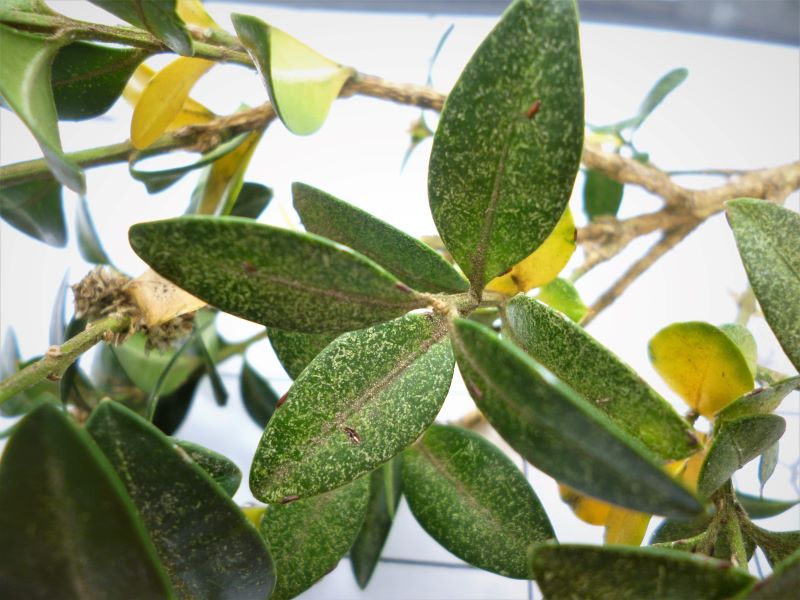
Boxwood spider mite feeding symptoms. This mite species creates linear streaks on leaves. (Photo Credit: Steven K. Rettke, Rutgers Coop. Ext.)
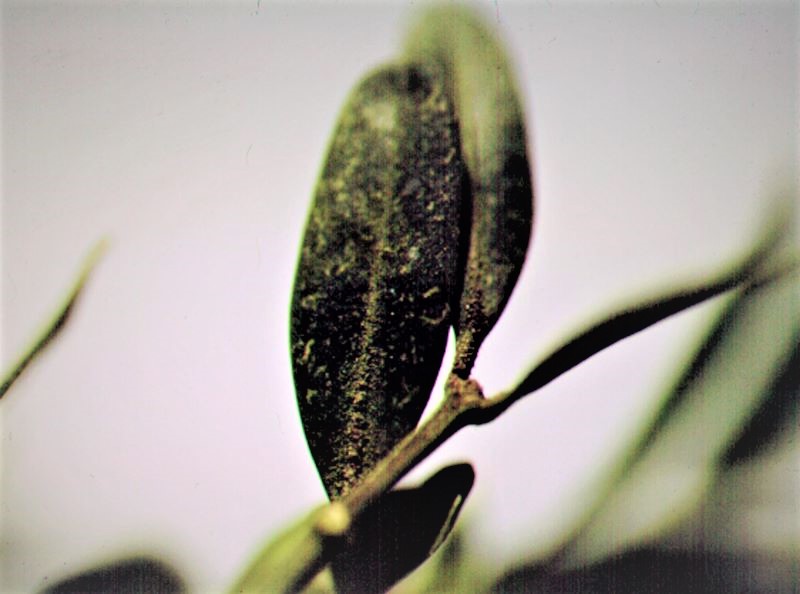
Boxwood spider mite symptoms that are more mild. The distinctive linear streaks are more clearly observed. (Photo Credit: Steven K. Rettke, Rutgers Coop. Ext.)
Detected overwintering eggs are treated with dormant oils (2-3%). Although normally unnecessary, summer oils (1-2%) or insecticidal soaps are recommended to control mild mite populations. With high infestations, some reduced-risk materials include spinosad, spiromesifen, acequinocyl, & bifenazate. Examples of other materials include hexythiazoc, abamectin, fluvalinate & acephate. Be aware that fluvalinate is a pyrethroid & can promote spider mite resurgence. Acephate may only provide mite suppression.
The Rutgers Plant & Pest Advisory Blog for Early June 2023 includes some commonly observed insect/mite & disease pests within the landscape during the late weeks of spring & early weeks of summer. In addition to boxwood spider mites, the other insect/mite pests included are juniper scale, bagworm, black vine weevil, bronze birch borer, pear leaf blister mite, & beneficial predacious mite. The disease pathogens included are fire blight, oak leaf blister fungus, black spot of rose, powdery mildew & Verticillium wilt. Some suggested monitoring techniques & variables are listed between the insect/mite & disease pests.
Juniper Scale (707-1260 GDD = crawler emergence): This imported armored scale insect is found on the foliage and twigs of primarily juniper and occasionally arborvitae. The female covers are circular and white (1/16 inch in diameter). The male covers are white and elongated and are smaller in size. Yellowish cast skins are attached to the surface of the waxy covering of both sexes. Adult females overwinter on the foliage and there is only one generation each year. With light infestations, there are often no apparent symptoms. Significant populations of 10 or more scales per ½ inch of twig can result in yellowed foliage and needle drop. Populations that remain unabated will result in dieback and an unattractive plant.
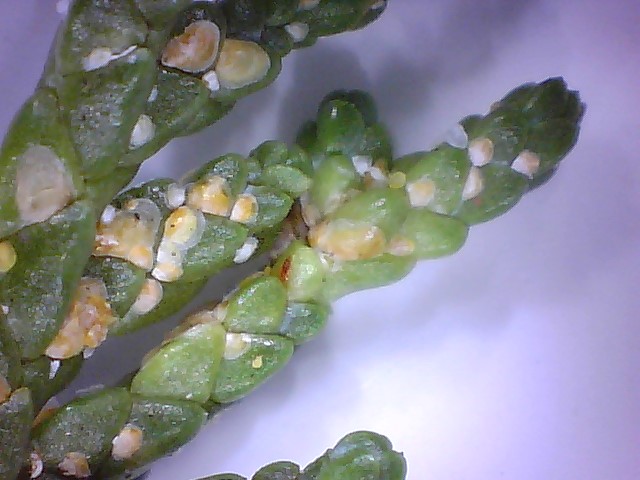
High infestation of juniper scales on false-cypress foliage. (Photo Credit: Steven K. Rettke, Rutgers Coop. Ext.)

Juniper scale insect exposed under waxy cover. All scale insects will leave a white ring when lifted off plant. (Photo Credit: Steven K. Rettke, Rutgers Coop. Ext.)
Scales usually build up first on the south side of shrubs or the side against buildings. With average seasonal temperatures, crawlers start hatching by mid-June and can continue well into July. Controls may not be required if many beneficials are present (i.e., especially monitor for dusty wing predators and parasitoid emergence holes in scale covers). Dormant oil sprays can be used, and summer oils or insecticidal soaps can be targeted against crawlers. A late summer systemic insecticide such as acephate (Orthene) can be applied if the crawler stage is missed.
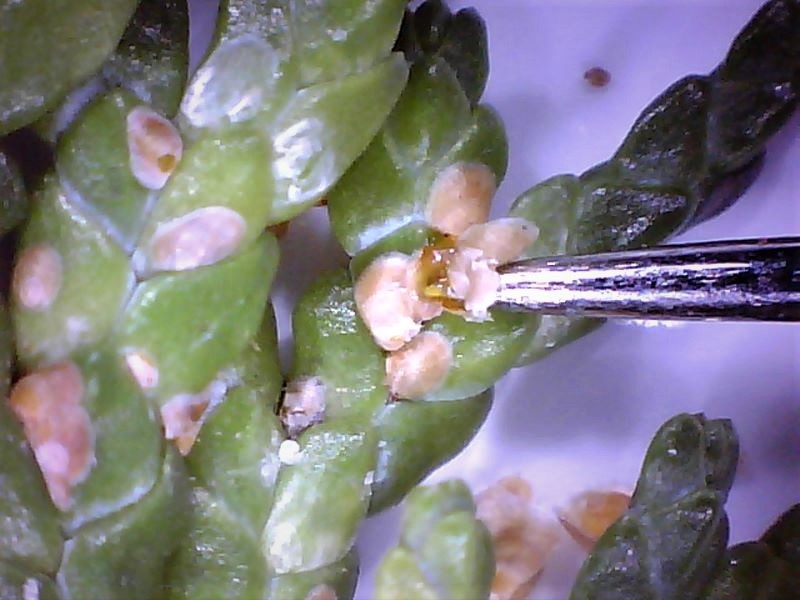
To determine scale viability, puncture scale to see if body fluids emerge. Photo Credit: Steven K. Rettke, Rutgers Coop. Ext.)
Bagworms (600-900 GDD = Best treatment periods): This caterpillar is native to the United States and is easily identified by the spindle-shaped sacks (or bags) that range in size from 1/8 to 2 inches in length depending on its maturity. The insects overwinter as eggs within the female bag. During early to mid-June the eggs hatch and the young caterpillars immediately spin a silken sack about themselves. As they feed, they attach bits of leaves to the bag, enlarging it as they grow. At this time, the bags are small enough to be carried on their backs in a pointed-up position.
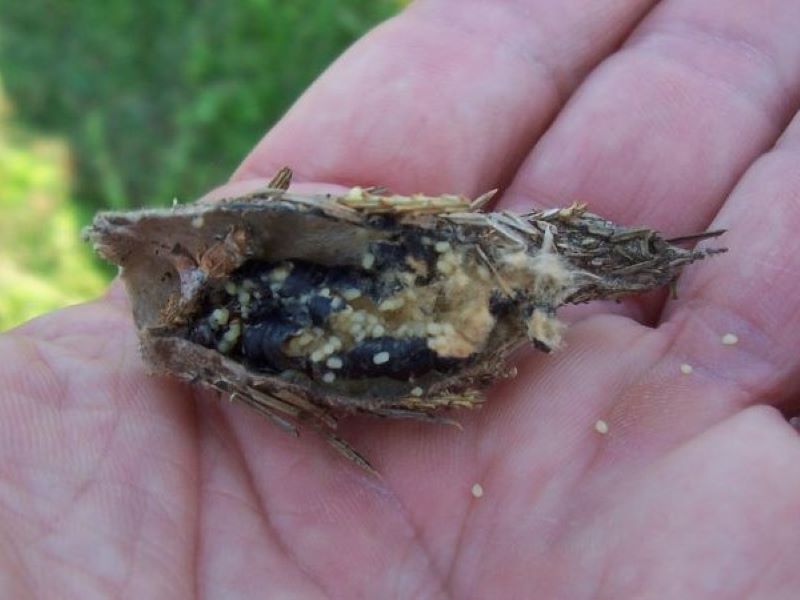
Overwintering bagworm egg sack will contain between 300-1000 eggs. Most will hatch during the month of June in NJ. (Photo Credit: Steven K. Rettke, Rutgers Coop. Ext.)

After hatch, up to 75% of first instar caterpillars will enter the ballooning stage & leave the parent plant. (Photo Credit: Steven K. Rettke, Rutgers Coop. Ext.)
Bagworms prefer evergreen conifers (Arborvitae in particular), but will also feed on many deciduous plants, leaving small “shot holes” in the foliage. During the early instar stages, control with B.t. (Bacillus thuringensis). By July, bags are larger and caterpillar feeding causes defoliation. At this point treat with reduced-risk insecticides such as spinosad or chlorantraniliprole. Many of the older, traditional caterpillar insecticides (e.g., carbaryl, acephate, & pyrethroids) will provide controls.
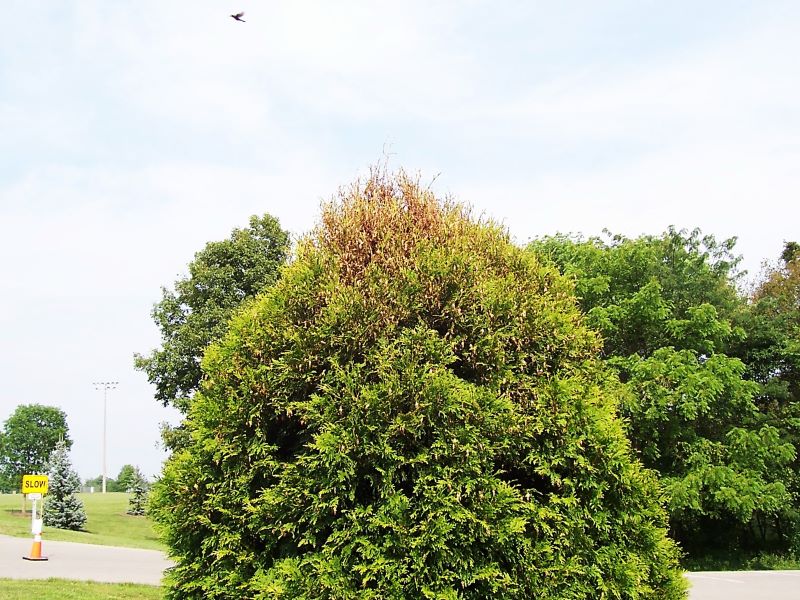
During the first couple of weeks in July, obvious feeding symptoms will be observed at the top of conifers. (Photo Credit: Steven K. Rettke, Rutgers Coop. Ext.)
Researchers in Kentucky have determined that most newly hatched bagworms disperse away from the ‘parental’ host plant. This may be because the offspring from only a few bags have the potential to defoliate a small plant. About 75% of immature bagworms disperse by ‘ballooning’ into the wind, traveling up to 250 feet. They can potentially travel much farther if emerging from elevated hills. This is how new bagworm infestations develop. Therefore, watch trees upwind from the problem tree you had last year. Failure to control populations upwind from a susceptible host may leave a potential reservoir of the pest in the future. (Reference: Cox and Potter, J. Arbor. 9/90)
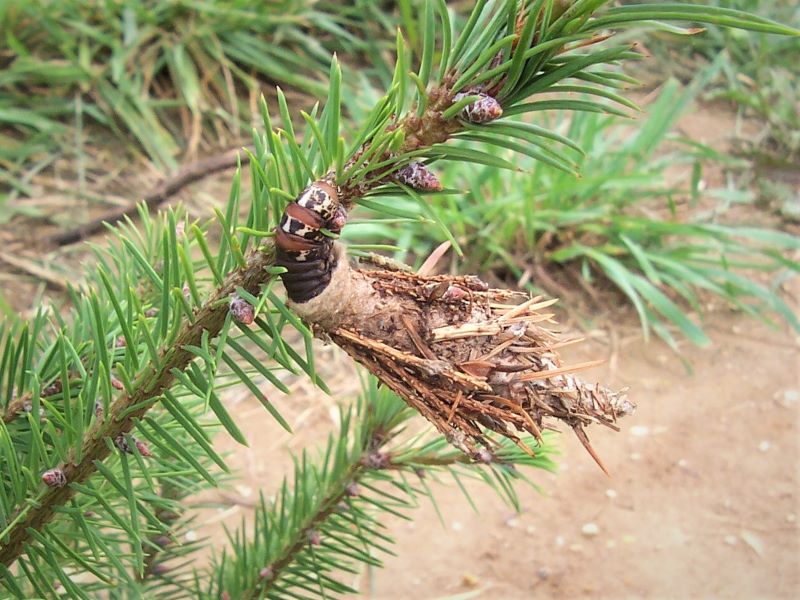
Full sized bagworm in the late weeks of summer. During September, most bagworms will enter the pupation stage. (Photo Credit: Steven K. Rettke, Rutgers Coop. Ext.)
Black Vine Weevils (Optimizing Treatments): Many landscape managers consistently state that attempting to manage the black vine weevil is one of the most problematic pests they encounter. These leaf-notching weevils feed on many kinds of ornamental plants including yews, rhododendrons, azaleas, laurels, leucothoe, forsythia, euonymus, hollies, viburnum, most deciduous and evergreen shrubs, ground covers and many kinds of perennials and annuals. Adults chew “C” notches in the margins of foliage. These notches tend to be small (1/4”) and distinct. BVW adults have long curved snouts and are black in color. The adults are most active during the early evening hours and are seldom visible during the day. Weevil larvae feed on the roots and crowns of plants. The larvae are white legless “C” shaped grubs with red/brown heads. They can be difficult to find when digging under a host plant. Feeding damage by larvae may cause a reduction in plant health, branch dieback, wilting, and sometimes death.
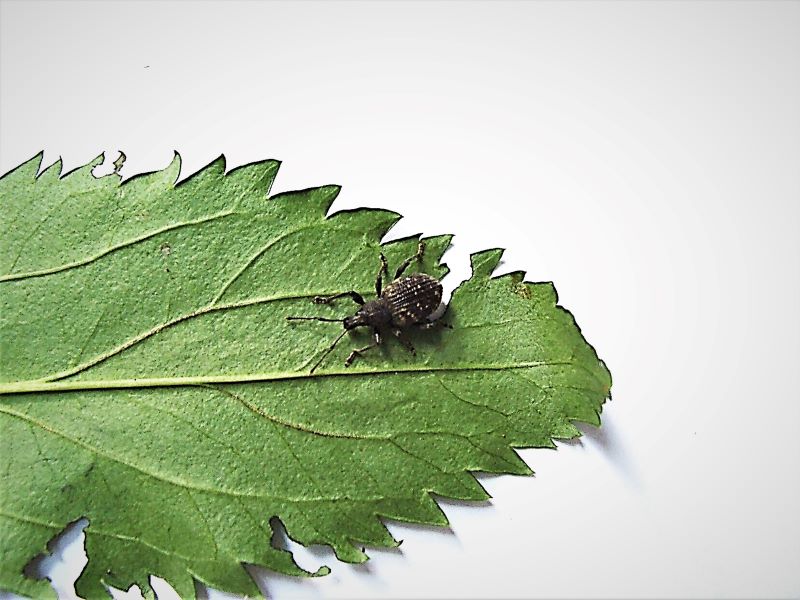
Black vine weevil larvae overwinter in the soil. Adults begin to emerge & feed during the weeks of June. (Photo Credit: Steven K. Rettke, Rutgers Coop. Ext.)
Probably the greatest reason landscapers struggle to control this pest is caused by poor timing of foliar sprays. Ideally, foliar sprays are applied to reduce the aesthetic injury caused by adults and subsequently prevent large populations of larvae from developing. To optimize treatments, it is important to understand that adults emerge to feed on leaves usually around late May to early June. The all-female adult population requires a feeding period of between 3 to 4 weeks before they are capable of laying eggs to start a new generation. The first eggs are usually laid when growing-degree-day (GDD) numbers reach 1000 (around late June to mid-July). Ideally, pesticides should be applied before 1000 GDD. After this point, adults begin laying eggs for the next generation. The best treatment window is during the time between the first feeding of adults and the 3 weeks that follow. One of the most successful management strategies has been to apply the 1st treatment when the first adults are observed and to follow up with a 2nd treatment 2 to 3 weeks later. Synthetic pyrethroids such as Talstar (bifenthrin), Tempo (cyfluthrin), Astro (permethrin), & Scimitar (lambda-cyhalothrin) provide controls of leaf feeding adults and have relatively long residuals.
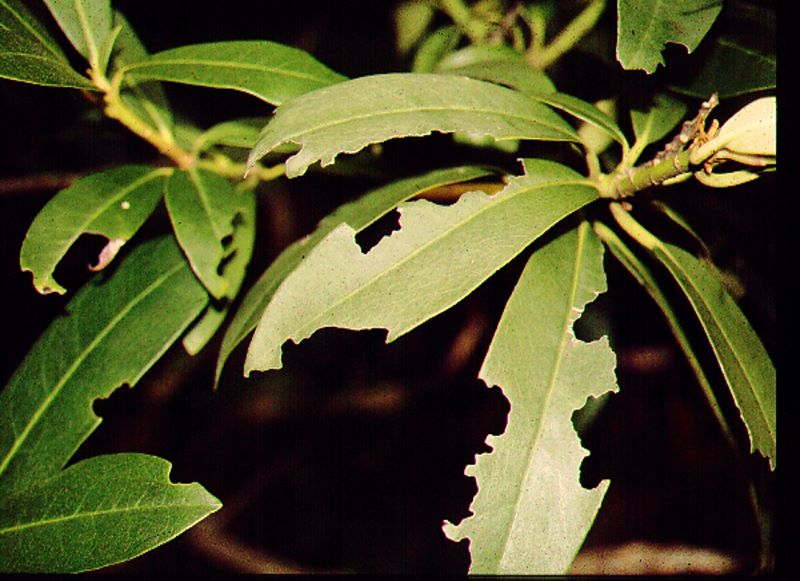
Black vine weevil adults feed on broad leaf evergreen leaves during the weeks of June. Their favorite hosts are azaleas, yews & rhododendrons. (Photo Credit: Steven K. Rettke, Rutgers Coop. Ext.)
Larvae may be killed with drenches of beneficial nematodes or Talstar (bifenthrin) during the summer and early autumn. Formulations of Talstar may provide season-long control when incorporated into potting mixes for container plants. The effectiveness of soil drenches in landscape situations is questionable.
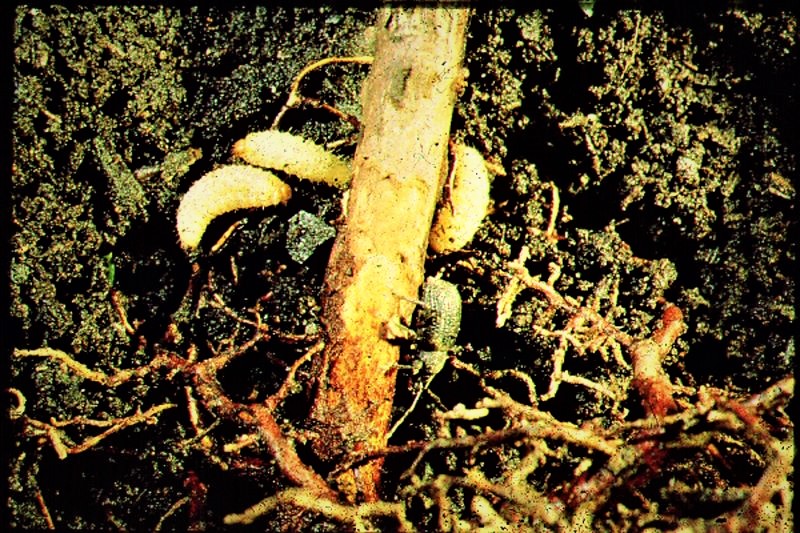
Legless, C-shaped black vine weevil larvae are 1/2 inch & feed on roots of host plants. (Photo Credit: Ohio State Coop. Ext.)
Beneficial nematodes can be effective against the larvae of black vine weevil. The use of beneficial nematodes has proven most successful in well-irrigated soil such as nursery containers. They do not seem to be effective in hot planter boxes with sporadic irrigation or in heavy clay soils.
Bronze Birch Borer (Agrilus anxius) =(440-800 GDD = egg-laying adults): Wood-boring insects can have devastating effects on trees & shrubs. Borers are the “true assassins” within the landscape. Although many plants are relatively tolerant of leaf-feeding herbivores, they cannot tolerate extensive feeding within their vascular systems. For example, bronze birch borer (BBB) beetle larvae feed within the phloem of birch and typically girdle branches or trunks. The resultant interference of the translocation of photosynthates (e.g., carbohydrates/starches) from the phloem to the roots results in tree starvation. Declining roots subsequently cause a reduction in the absorption of water and nutrients that results in the death of the top of the tree. The tree declines from the top down because of hydraulic resistance. It is a myth that the bronze birch borer attacks the top of a birch tree first. This wood-boring species attacks anywhere on the tree where branches exceed one inch in diameter but are especially attracted to bark wounds.
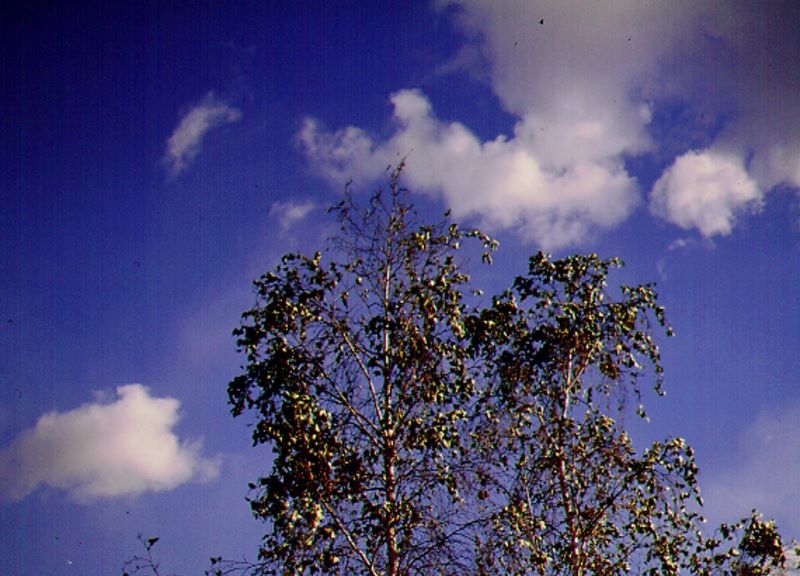
Birch tree symptoms of bronze birch borer infestation. Dieback at top of tree is often the first indication of a borer infestation. (Photo Credit: Steven K. Rettke, Rutgers Coop. Ext.)
Since it is now the first week of June, the adults of this metallic beetle have become active in southern & central NJ. It will not become active for another week or more in many of the more northern areas of NJ. Nevertheless, it is important to take the time to monitor susceptible birch species that may require protective treatments. During the month of June, this beetle will lay eggs on birches (primarily European white, Asian white, paper, and gray birch) that are under stress (drought stress, heat stress, compacted soil, etc.). The bullet-shaped, metallic black adult beetle (1/2”) lays eggs on branches as well as the main trunk. Monitor for adult activity and last year’s exit holes, which are shaped like the letter “D” (1/4”). Symptoms include dieback from the upper branch tips, working down the tree toward the base. Sometimes “ripples” are noticed beneath the bark.
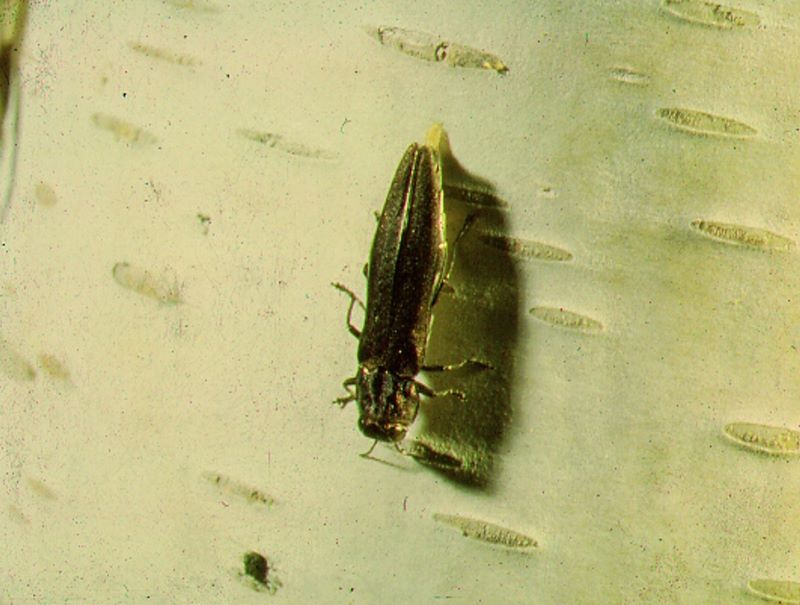
Bronze birch borer adult laying egg on birch bark. (Photo Credit: Ohio State Coop. Ext.)
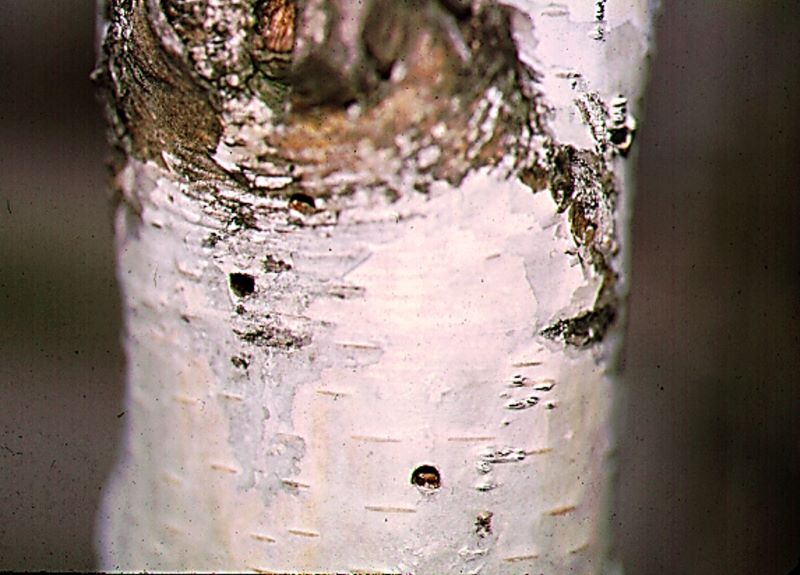
Bronze birch borer adult D-shaped emergence holes from tree stem. (Photo Credit: Steven K. Rettke, Rutgers Coop. Ext.)
Remember, a wood borer is present because the tree is already under stress. Relieve stress as much as possible by watering during drought conditions, mulching, fertilizing, controlling birch leaf miners, and pruning out dead wood (but not just before adult emergence, since adults are attracted to wounds to lay eggs). Pesticide bark sprays are effective when timed to target newly hatched larvae as they chew through the bark into the tree. Pyrethroid insecticide treatments offer good control (i.e., provide a 3-week residual) if the bark is thoroughly wet since eggs are laid in many small cracks and crevices. Systemic insecticides (e.g., neonicotinoids) applied to the soil or as bark sprays/trunk injections offer excellent protection. BBB will often be more severe this year following a drought that occurred during the previous summer. European and Asian birch species are highly susceptible to invasion by the BBB. Our native birch trees (e.g., paper, gray, yellow) have some resistance (i.e., if not under stress) against this native wood borer. The River Birch var. ‘Heritage’ is highly resistant to the BBB.
Pear Leaf Blister Mites: The familiar Callery ‘Bradford’ pear, is a relatively pest-free ornamental tree that is attacked by the pear leaf blister mite. Its feeding causes the formation of galls or blisters on the leaves. These blisters are from yellow to green at first, becoming red, & finally black on the leaves of the pear. Many blisters may coalesce, discoloring large continuous patches on the leaves. The blisters will often form parallel lines that run along each side of the central leaf vein.

Pear leaf blister mite symptoms will be most prominent on the undersides of infested leaves. (Photo Credit: Steven K. Rettke, Rutgers Coop. Ext.)
These white, elongated, four-legged eriophyid mites are responsible for the damage & are exceptionally small (less than 1/100th of an inch). At least 20X magnification is required to observe these mites. They winter beneath the bud scales & become active & lay eggs when the buds begin to swell in warm spring weather. They produce their characteristic injury by feeding & burrowing into the undersides of the leaf tissue. A succession of overlapping generations develops throughout the summer that migrates to other leaves. They overwinter in bark crevices & under bud scales.
Plants with a history of eriophyid mites should receive a dormant oil application to suppress the overwintering stage. They can also be treated whenever they are detected reaching damaging levels by using summer oils & soaps. The reduced-risk miticide spiromesifen can be effective against eriophyid mites. Although carbaryl should never be used to attempt to control spider mites, it can be effective against eriophyid mites.
Predacious Mites: Be on the lookout for beneficial mites that can commonly be found in and amongst two-spotted spider mite populations. These “good” mites naturally keep the “bad” two-spotted mites under control. Common predaceous mites are in the family Phytoseiidae. Phytoseiid mites lay their eggs singly in spider mite populations on the bottom surface of leaves along the veins. Their eggs are about the same size as spider mite eggs. All stages of Phytoseiid mites are oval and shiny-white to tan in color. These adult predacious mites can be distinguished from adult spider mites by their shiny, unspotted pear shape with hairs that are less noticeable than spider mites. On a beating tray, they also move much faster than spider mites.
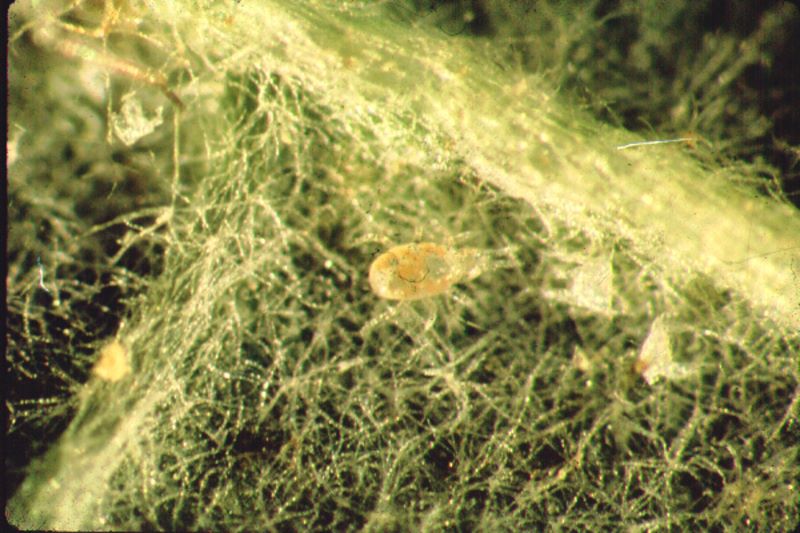
Many predacious mite species will be pale in color with few body hairs. They have long legs & can move much faster than spider mite pests. (Photo Credit: Ohio State Coop. Ext.)
During a lifetime, a predaceous mite can consume an average of 20 pest mites, with some species consuming more than 100 each. Adult females lay about 60 eggs over several days, and even more if a greater number of prey mites are present. Mated females overwinter in deep bark crevices. (Reference: Davidson, J.; Landscape IPM Guidelines for Trees & Shrubs, Univ. of Maryland. Bull. 350)
Desirable IPM Insecticides: There are several characteristics that ideal IPM insecticides should offer. In reality, it is rare for a particular insecticide to possess all of these characteristics. Nevertheless, appropriate IPM insecticides should still be able to satisfy at least some of the following: 1) It should be as specific as possible for the target pest. 2) It should give adequate control. 3) It should have a short residual 4) It should not eliminate the presence of beneficials for more than a day. 5) It should be low risk to plants, applicators, and the environment. 6) It should be economical.
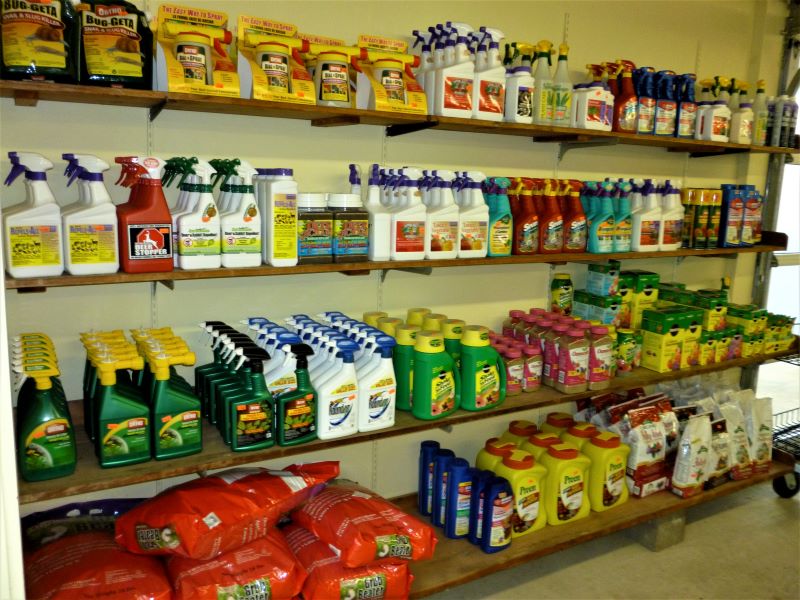
There are no perfect IPM pesticides. However. some are better than others. (Photo Credit: Steven K. Rettke, Rutgers Coop. Ext.)
IPM Scouting Fundamentals: Some commentary to consider for improving routine monitoring effectiveness: (1) – Make it a common practice to reverse directions each time you visit a specific property. It is surprising what may be observed when scouting in one direction that is completely overlooked when moving in the opposite direction. (2) – Scouting the same property at different times of the day can uncover possible problems that may be less obvious during a certain time of day. Shadows and sunlight angles change throughout the day which can mask or enhance plant symptoms or signs. (3) – Scouting during overcast days will typically provide ideal visual conditions. The subtle color variations of plant foliage are best observed without the sharp contrasting shadows from bright sunlight.
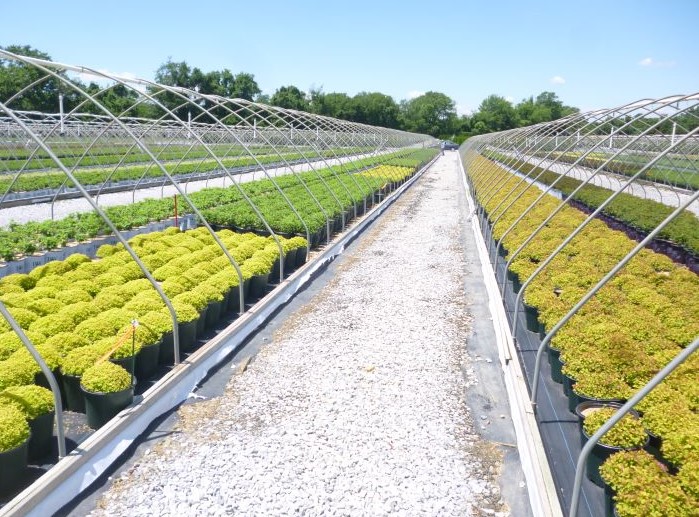
Scouting observations are compromised during bright & sunny days. Harsh contrasts between light & shady areas on plants are created. (Photo Credit: Steven K. Rettke, Rutgers Coop. Ext.)
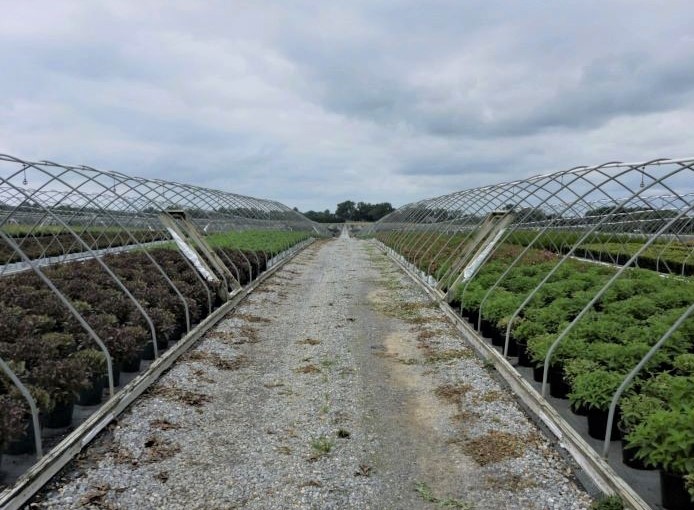
It is counterintuitive, but visually, cloudy days create better scouting observations on plants. (Photo Credit: Steven K. Rettke, Rutgers Coop. Ext.)
The Magnifying Hand Lens is an Essential Tool: Of the many helpful tools that an IPM scout uses, arguably the most important may be a magnifying hand lens. Improving the abilities of the eyes to see the tiny world of insects and disease organisms will improve IPM decision-making in the field.
A hand lens is a tool that magnifies the small area of interest and can conveniently be placed in a pocket or worn around the neck, where it is always handy. Landscape pest managers not routinely using the aid of a hand lens are working at a great disadvantage. Once it is discovered how valuable the proper use of a hand lens is when monitoring, it soon becomes an indispensable tool.
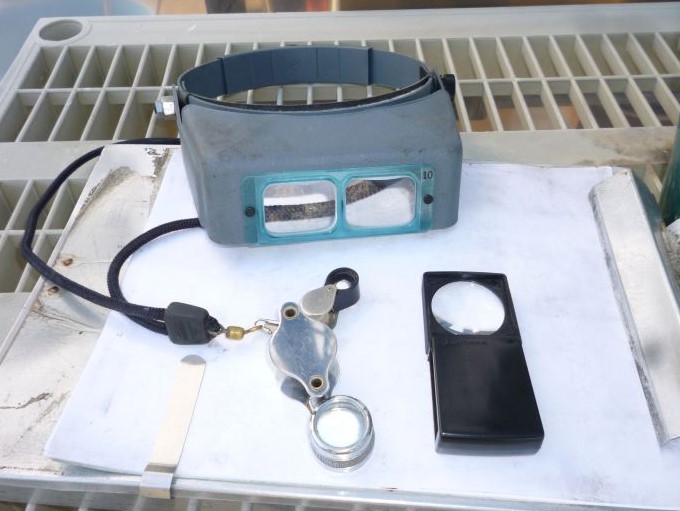
Several types & powers of magnifying lens. The 4 types shown range in power from 3X to 20X. (Photo Credit: Steven K. Rettke, Rutgers Coop. Ext.)
Fire Blight Bacterial Disease (Erwinia amylovora): The fire blight disease is caused by the Erwinia amylovora bacterium. This disease attacks plants belonging to the rose family but is most damaging to apples & pears. The bacteria live from one season to the next in branch & twig cankers on infected plants. In the spring, the cankered areas produce a white to orange-colored ooze. Wind, rain, & insects can carry this bacterial ooze to infect new foliage, flowers & fruit of susceptible plants. Disease development is favored by warm temperatures between 65-80°F.
Diseased flower blossoms become water soaked & turn brown. Newly infected twigs are watery, dark green, & somewhat oily. When these infected twigs dry, they darken in color & the branch terminals appear to have been scorched by fire, but the leaves do not drop. The “burned” terminals produce characteristic symptoms resembling a “shepherd’s crook” or upside down “j.” The infection becomes more serious when the bacteria enter through wounds or natural openings & move into the main branches. The cankered areas produce light brown bark that becomes sunken & cracked. If the collapsed vascular tissue girdles the branch, then the above portion of the plant dies.

Characteristic symptoms of a fire blight bacterial infection on an apple tree. (Photo Credit: Steven K. Rettke, Rutgers Coop. Ext.)
In dry weather, prune out infected branches at least 6” below the infected wood. Dip pruners in rubbing alcohol between cuts. Avoid using too much nitrogen around fire-blight-prone plants so as not to produce excessive amounts of soft, succulent growth. Next spring, copper fungicides or bactericides can be used, however, many orchardists question the value of such sprays. Furthermore, the frequency of applications required & the cost of these materials may not be practical in the landscape. Replace with a resistant variety.
Oak Leaf Blister Fungus (Taphrina caerulescens): This fungus causes concave or convex bulging leaf blisters on the leaves of about 50 species of oaks. The fungus causes abnormal cell division & enlargement by secreting growth-regulating chemicals. They often attract a lot of attention when they become apparent during the late spring. Tissues that are distorted have typical brown discoloration. Some of the infecting spores overwinter and survive on twigs & bud scales that can infect new leaf growth during the spring.
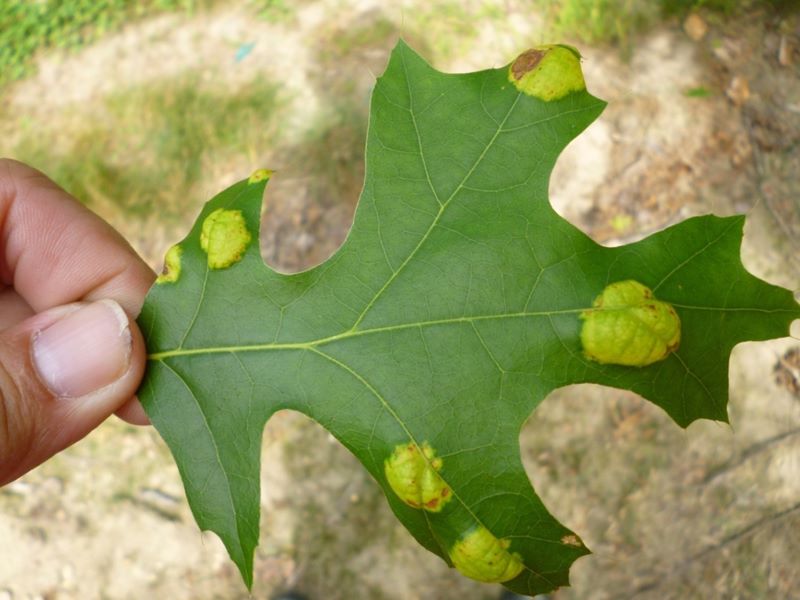
Top view of the large convex leaf blisters on this red oak leaf. (Photo Credit: Steven K. Rettke, Rutgers Coop. Ext.)
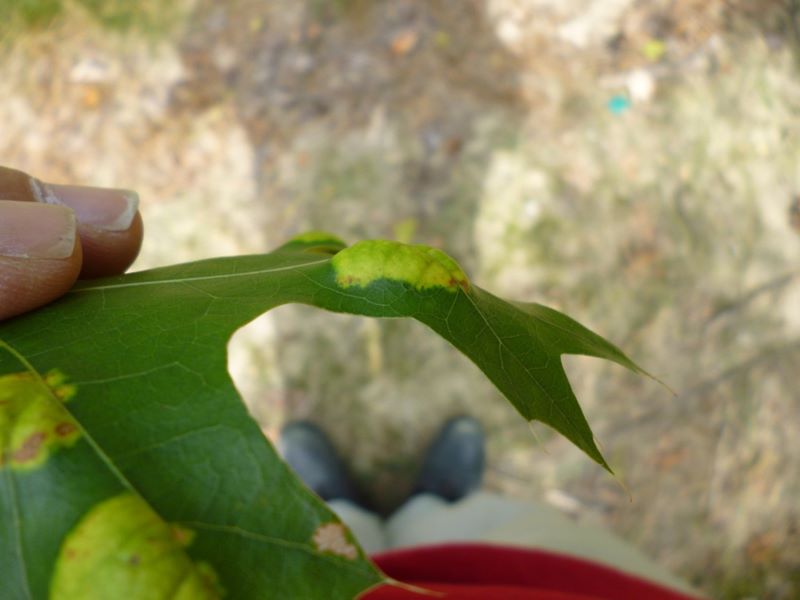
Side view of convex blister on red oak. Oak leaf blister fungus causes curiosity, but is mostly cosmetic. (Photo Credit: Steven K. Rettke, Rutgers Coop. Ext.)
This disease is rarely serious enough to affect oak trees’ health or appearance. If previous history warrants fungicide treatments, then spray once in the spring, before bud break with chlorothalonil or mancozeb.
Black Spot of Rose (Diplocarpon rosae): Black Spot is a common fungal disease that can defoliate, weaken, and kill susceptible roses. Spores produced from previously infected tissue infect young (1-2 weeks old) leaves Leaf surfaces must be continually wet for at least 7 hours for spores to penetrate. Foliar symptoms, which include black spots 1/10 to ½ inches in diameter, appear 3-16 days after infection. These spots have feathery edges & are accompanied by yellow “halos” of leaf tissue surrounding the lesions. Spores produced in these spots continue to infect newly expanding leaves and canes during the summer. Affected leaf tissues turn yellow & defoliate prematurely.
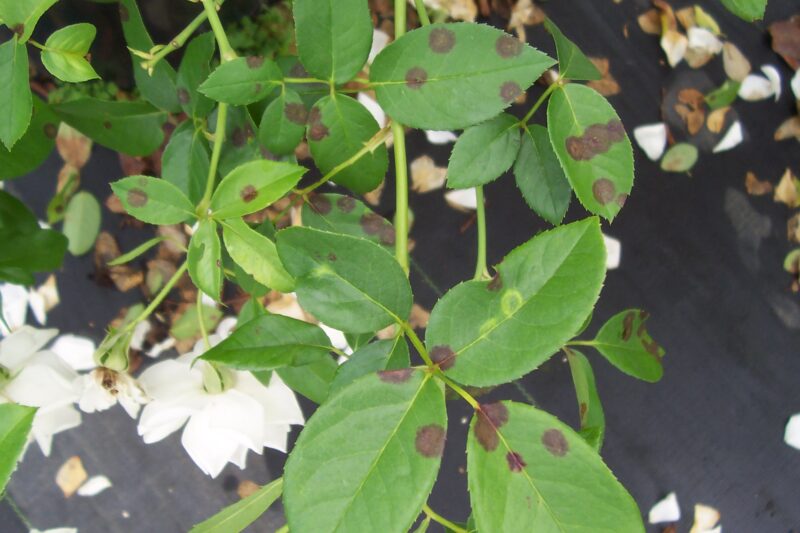
Black spot of rose infection symptoms. Fungus lesions can be up to 1/2 inch in diameter. (Photo Credit: Steven K. Rettke, Rutgers Coop. Ext.)
On new canes, irregular, raised red-purple blotches (cankers) appear, which become blackened & blistered. The fungus overwinters on diseased leaves & canes, so cultural management of black spot disease includes raking old leaves, pruning diseased & damaged canes, and spacing plants so foliage dries out. Roses are usually sprayed with fungicides after pruning. Fungicides (e.g., chlorothalonil) are applied in mid-May and repeated at the intervals specified on the label.
There are many newer rose varieties & hybrids now available that have some resistance to black spot disease. However, roses available on sale at mass retail outlets may still include many susceptible varieties.
Powdery Mildew of Rose & other plants: (Sphaerotheca genera): Powdery Mildew symptoms include white patches of powdery spores on the leaves, flowers, and shoots. Infected new growth is often distorted & twisted, and flowers may be of poor quality. Raking leaves, pruning diseased canes, and spacing plants help reduce powdery mildew as well. This disease does best during hot & humid conditions of summer. Powdery mildew fungal spores are surrounded by a microscopic ring of slime that is full of water. Therefore, as the spores travel through the air, they carry their own water supply. This water helps the spores to infect susceptible hosts they land on. In fact, free water on leaves is damaging to this fungus. This fungus is primarily cosmetic & is not usually considered to be a plant health concern.
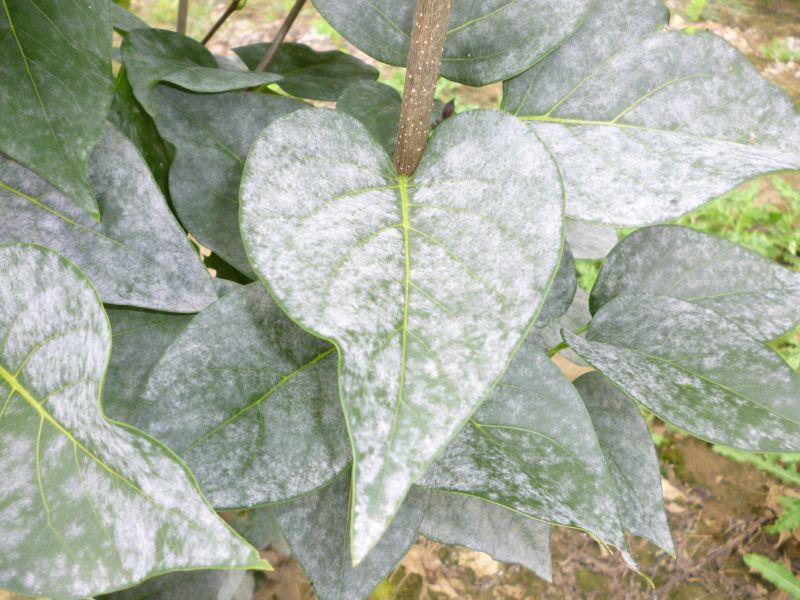
Powdery mildew infection on lilac leaves in late summer is the classic example of this disease within the landscape. However, this disease can begin to be seen on certain plants throughout the late spring & summer months. (Photo Credit: Steven K. Rettke, Rutgers Coop. Ext.)
Repeat fungicide treatment is necessary to control foliar diseases, as they protect the leaf from infection only. Some fungicides labeled for protection include copper and thiophanate-methyl. Some reduced-risk materials are labeled, such as Neem oil & baking soda, but phytotoxicity concerns need to be considered, especially on roses. Also, antitranspirant materials applied to the surface of leaves can reduce infections. This can provide a 30-day residual in the landscape. Once infections are established within leaves, these materials will only suppress the mycelium that is on the leaf surface but will not eliminate the disease. Therefore, repeat applications are required.
Verticillium Wilt (Verticillium): This fungus is one of the most destructive diseases of shade trees & ornamental plants, with more than 300 plants attacked. Maples appear to be the most susceptible, especially Japanese, Norway & sugar maples. Japanese barberry, Catalpa golden raintree & privet are also susceptible. Since Verticillium Wilt is so common within maples, there is a tendency for landscapers to implicate it as the cause of symptoms before proper diagnostic signs are investigated. Therefore, it is probably one of the most overly diagnosed diseases in the landscape when other causes are to blame.
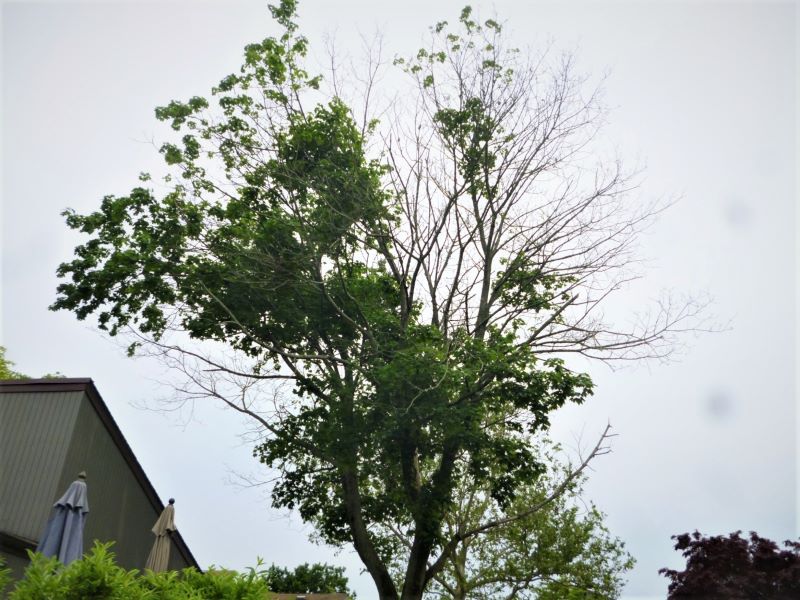
Advanced infection of Verticillium wilt on Norway maple. Death of multiple branches has occurred. (Photo Credit: Steven K. Rettke, Rutgers Coop. Ext.)
This disease is caused by a soil-borne fungus that attacks the root system. The initial symptoms appear as sudden wilting of leaves on one or several branches. This often becomes evident during moisture-stress periods of the summer months. Infected branches often show an olive-green to black discoloration in the young or outer sapwood when cut branches are examined. This discoloration is not always easy to find because it may occur up to several feet below the point where leaves are wilting.
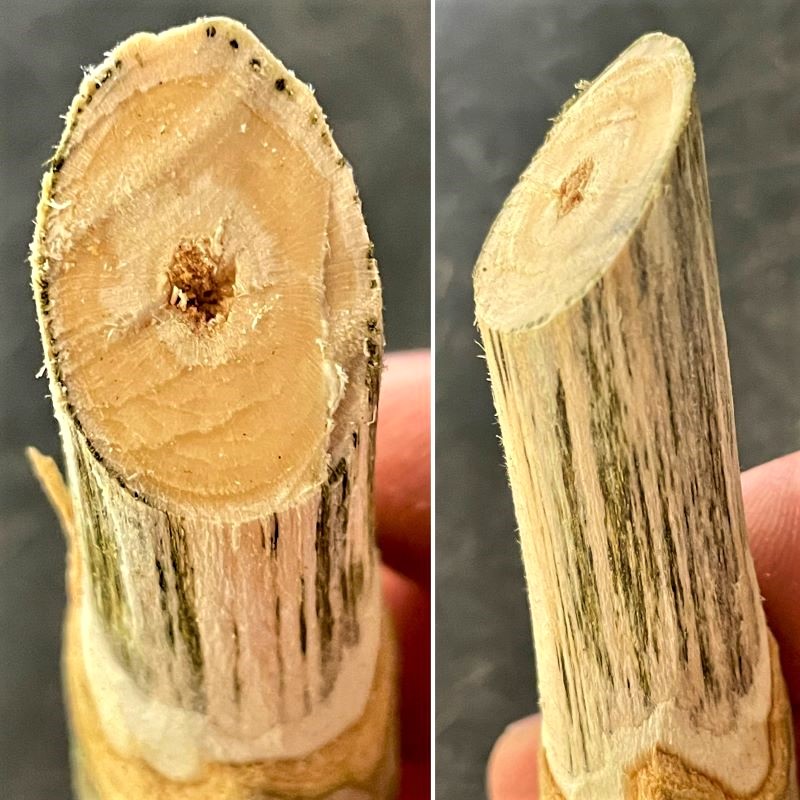
Green colored vascular streaking beneath bark of a Verticillium wilt infected stem. (Photo Credit: UMass Coop. Ext.)
Fungal growth is favored by cool soil temperatures. Stressed conditions such as excessive wet or dry periods from seasons past can cause root injuries which make them prone to invasion. Mechanical wounds near the soil line or on the roots also favor the entry of the fungus.
Verticillium Wilt is not curable with fungicides. The reason it often takes many years for infected trees to die is that the fungus cannot overwinter within the tree. The fungus must start again from the soil to move up into the branches & reinfect the tree each season. The life of infected plants can be prolonged with proper cultural practices, but eventually, the plant will succumb.
Reference: Managing Insects and Mites on Woody Plants: an IPM Approach; John A. Davidson, Ph.D., and Michael J. Raupp, Ph.D., Dept. of Entomology, Univ. of Maryland
Reference: Scouting and Controlling Woody Ornamental Diseases in Landscapes and Nurseries; Gary W. Moorman, Ph.D., Penn State College of Agricultural Sciences
Reference: Field Identification of Insects and Diseases on Trees and Shrubs, July 2006; George Hudler, Ph.D., Cornell University and Gregory Hoover, Penn State Coop. Ext.

